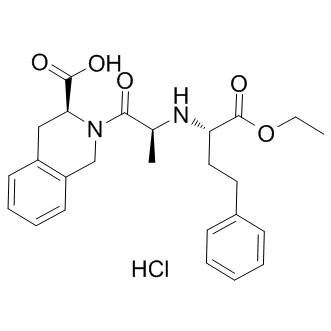All AbMole products are for research use only, cannot be used for human consumption.

Quinapril hydrochloride (Accupril) is the hydrochloride salt of quinapril that is an angiotensin-converting enzyme inhibitor with a Ki of 20 μM. Quinapril hydrochloride (Accupril) used in the treatment of hypertension and congestive heart failure. Quinapril is a prodrug. Quinapril is converted to its active metabolite, quinaprilat, in the liver. Quinapril inhibits angiotensin converting enzyme, an enzyme which catalyses the formation of angiotensin II from its precursor, angiotensin I. Angiotensin II is a powerful vasoconstrictor and increases blood pressure through a variety of mechanisms. Due to reduced angiotensin production, plasma concentrations of aldosterone are also reduced, resulting in increased excretion of sodium in the urine and increased concentrations of potassium in the blood.
| Molecular Weight | 474.98 |
| Formula | C25H30N2O5.HCl |
| CAS Number | 82586-55-8 |
| Solubility (25°C) | Water 90 mg/mL Ethanol 90 mg/mL |
| Storage |
Powder -20°C 3 years ; 4°C 2 years In solvent -80°C 6 months ; -20°C 1 month |
[1] Beata Stanisz. The influence of pharmaceutical excipients on quinapril hydrochloride stability
[3] H R Kaplan, et al. Quinapril: overview of preclinical data
[4] D Canter, et al. The safety profile of quinapril: is there a difference among ACE inhibitors?
| Related ACE Products |
|---|
| Enalapril
Enalapril (MK-421) is an angiotensin-converting enzyme (ACE) inhibitor. |
| Enalaprilat
Enalaprilat (MK-422 anhydrous), the active metabolite of the oral proagent Enalapril, is a potent, competitive and long-acting angiotensin-converting enzyme (ACE) inhibitor, with an IC50 of 1.94 nM. |
| Deserpidine
Deserpidine (Harmonyl) is an alkaloid isolated from the root of Rauwolfia canescens related to Reserpine. |
| H-Ile-Pro-Pro-OH hydrochloride
H-Ile-Pro-Pro-OH hydrochloride, a milk-derived peptide, inhibits angiotensin-converting enzyme (ACE) with an IC50 of 5 μM. |
| N-Benzoyl-Gly-His-Leu hydrate
N-Benzoyl-Gly-His-Leu hydrate is a leucine derivative, a polypeptide. |
All AbMole products are for research use only, cannot be used for human consumption or veterinary use. We do not provide products or services to individuals. Please comply with the intended use and do not use AbMole products for any other purpose.


Products are for research use only. Not for human use. We do not sell to patients.
© Copyright 2010-2024 AbMole BioScience. All Rights Reserved.
